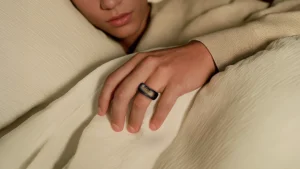
You can see smartwatches like the Apple Watch Series 10 and Samsung Galaxy Watch are very popular in 2025. You also see smart rings, like the VERTU Meta Ring, becoming important for style and health tracking. Other Wearable Tech Devices are fitness trackers and smart clothing. These help you watch your health and daily steps.
-
Smartwatches
-
Smart Jewelry (Smart Rings)
-
Fitness Trackers
-
Smart Clothing
The VERTU Meta Ring has a fancy look and strong sensors. This makes wearables cool to wear and helpful.
|
Metric |
Value |
|---|---|
|
Global AI wearables market (2023) |
|
|
Expected market size (2033) |
US$304.8 billion |
|
CAGR (2024-2031) in North America |
27.8% |
AI and design make wearables better. They help you learn about your health more than ever before.
Key Takeaways
-
Smart wearables like smartwatches and rings are changing health tracking. They make it cool and easy for everyone to use.
-
Generative AI gives health tips that fit each person. It helps people make better choices using their own data.
-
Advanced sensors in wearables check important body signs all the time. This helps find health problems early.
-
Smart clothing uses technology to watch health in real time. It makes athletes feel better and do better.
-
The global wearables market is growing very fast. More people care about health and new technology helps this growth.
Wearable Tech Devices Shaping 2025

VERTU Meta Ring: Luxury Health Innovation
The VERTU Meta Ring is a top smart jewelry in 2025. It mixes fancy style with new health tech. The Meta Ring uses nano-sensors to check your sleep, heart rate, blood pressure, and glucose. You get a wellness report every week. This helps you learn about your body and make better choices. The ring’s crystal design feels nice and looks great. You can wear it all day. It fits your life with night mode and cinematic mode. The Meta Ring is like a health helper. It gives you early warnings and tips for better health. You get wearable tech that is both smart and stylish.
The Meta Ring is special for people who want style and health. You feel the touch and see what matters most.
Grand Watch and Smartwatches
Smartwatches and grand watches change how you track health and daily life. These devices watch your health all the time, not just at the doctor. You can see health data that helps doctors give better care. This is useful where normal checks are hard.
Here is a comparison of top smartwatch brands in 2025:
|
Brand |
Model |
Price |
Special Functions |
Compatibility |
|---|---|---|---|---|
|
Apple |
Apple Watch Series 10 |
~$429 |
ECG, heart-health alerts, blood-oxygen sensor, temperature sensor, sleep-apnea detection |
iOS only (iPhone) |
|
Samsung |
Galaxy Watch 7 |
N/A |
Dual-band GPS, advanced health sensors, Sleep Coach feature |
Android |
|
Garmin |
Venu 3 |
$449.99 |
14-day battery life, wellness tracking, built-in GPS, offline music |
iOS and Android |
|
Mobvoi |
TicWatch Pro 5 |
~$349 |
Dual-layer display, 80 hours battery life, ruggedness, Snapdragon W5+ processor |
Android only |
|
Xiaomi |
Watch 2 |
~$199 |
Wear OS, Snapdragon W5+ chip, dual-band GPS, 150+ sports modes |
Android only |
|
Amazfit |
Active 2 |
$99 |
24/7 health monitoring, built-in GPS, 100+ sports modes, Alexa assistant |
iOS & Android |
Smartwatches now use generative AI for health tips. You get alerts and advice made just for you. Many watches work without a phone. Dual-frequency GPS helps you find your location better. Fancy smartwatches mix good looks with smart features. This makes wearable tech both cool and useful.
-
You get health tips just for you.
-
You get alerts for health problems.
-
You use altimeters and barometers for outdoor fun.
-
Fancy brands give AI-powered style help.
Fitness Trackers and Smart Rings
Fitness trackers and smart rings help you get healthier. These devices use AI and sensors to give you advice. You get a health baseline, and the device learns from your data. This helps it give better tips.
-
AI rings show your sleep and give activity tips.
-
You get stress alerts and early illness warnings.
-
The device checks your recovery and keeps you healthy.
-
Smart rings have sensors that measure health very well.
-
Fitness trackers and rings use machine learning to check your health.
-
You get reminders for water and food.
-
These devices help you stop problems before they get worse.
Fitness trackers and smart jewelry are popular. They are small, comfy, and easy to wear every day.
Smart Clothing and Implantables
Smart clothing and implantable tech change how you watch your health. Companies like Hexoskin, Sensoria, Myontec, OMsignal, and Wearable X make smart shirts, socks, shorts, and yoga pants with sensors. You use these clothes to check your vital signs, muscles, posture, and breathing.
|
Development Type |
Description |
|---|---|
|
Smart Clothing |
Embedded sensors for monitoring posture, heart rate, and muscle activity. |
|
Sports Applications |
Real-time performance analysis, muscle activation monitoring, and injury prevention. |
|
Healthcare Applications |
Continuous vital sign monitoring, posture correction, and fall detection systems. |
|
Leading Companies |
Hexoskin, Sensoria, Myontec, OMsignal, Wearable X developing innovative smart textiles. |
|
Innovations |
Miniaturization of sensors, energy-harvesting textiles, and washable electronic components. |
Smart clothing helps you check vital signs, fix posture, and recover. Skin sensors help you take medicine on time. Fall alerts and emergency help keep older people safe. Athletes use smart clothing for body tracking. These devices are comfy and hard to notice, so you can wear them every day.
-
Wearable tech can cut hospital costs by 16% in five years.
-
Remote monitoring could save $200 billion in 25 years.
-
Smart clothing helps athletes track muscles and breathing.
-
You get comfy, all-day wear for health and fitness.
Wearable tech leads the way in 2025. It makes health checks easier, more exact, and more stylish. You can pick smart jewelry, fitness trackers, smartwatches, or smart clothing to fit your life.
Key Trends in Smart Wearables

Generative AI and Personalization
Generative AI is changing how you use wearables. Devices learn from your habits and health data. Your smartwatch can pick the best workout for you. It changes reminders when you feel stressed. Generative AI works in real time. Your device acts like a helper. You get health scores and tips that match your life. This technology helps you stay healthy. It makes your experience more personal.
Tip: Let your wearable give you smart ideas for your daily routine.
Advanced Health Sensors
New health sensors track more things than before. Wearable tech checks heart rate, sleep, and stress levels. Devices like Huawei Band 10 and Oura Ring 4 watch over 20 biometrics. They check blood oxygen and body temperature. Some wearables do ECG monitoring all the time. They also check sweat for health markers. These sensors help you know your body better. You can spot health changes early.
|
Device Name |
Features |
|---|---|
|
Huawei Band 10 |
Sleep tracking, heart rate variability, arrhythmia analysis, 100 workout modes |
|
Oura Ring 4 |
Heart rate, blood oxygen, body temperature, stress, sleep quality |
|
VitalPatch |
Continuous ECG, heart rate, respiratory rate, body temperature |
Flexible Fabrics and Smart Clothing
Flexible fabrics make smart clothing comfy and stylish. Conductive fibers and printed electronics hide sensors in shirts, socks, and pants. These materials keep you comfy while tracking health. Sensors check posture, muscle activity, and breathing. Wireless tech like Bluetooth and 5G sends your data fast. Real-time analytics give feedback to help your health and performance.
-
Flexible electronics make smart clothes easy to wear.
-
Conductive fibers let sensors work without feeling heavy.
-
Wireless tech links your clothes to your phone or cloud.
Continuous Glucose Monitoring
You can check glucose levels without needles now. Devices like Glucowear™ use microwave resonance and AI. They check glucose through your skin. You wear it on your wrist and connect by Bluetooth. The device collects data in real time. You get pain-free monitoring. This helps people with diabetes manage health easily. The technology shows wearables use non-invasive ways for better care.
|
Feature/Innovation |
Description |
|---|---|
|
Device Name |
Glucowear™ |
|
Technology |
Microwave resonance-sensing and AI |
|
Monitoring Type |
Non-invasive, continuous |
|
User Experience |
Comfortable, wearable on wrist, Bluetooth connection |
|
Pain-free |
No skin penetration required |
Note: Non-invasive monitoring is a key new trend in wearables.
Smart Wearables Market Analysis
Global Wearables Market Growth
The global wearables market is growing quickly in 2025. The market size for smart wearables in 2025 is USD 209.8 billion. Many people want to track their health and fitness. These are the main reasons for growth:
-
More people use health monitoring devices because they care about their health.
-
New technology gives longer battery life and smarter AI features.
-
Smartglasses and earwear are more popular for daily use.
-
The global market has smartwatches, smart rings, smartglasses, and earwear.
Smartglasses change how you see information. They show data right in front of your eyes. Earwear lets you listen to music, take calls, and track health at the same time.
Regional Adoption Patterns
Asia Pacific is leading in using smart wearable devices. Countries like China, India, Japan, and South Korea use more smartglasses, earwear, and fitness trackers. People in these countries want better health and new technology. China is important, with 30% of the global wearable band market in 2024 and a 20% growth rate. North America is also big in the wearables market. There are many tech companies and new ideas there. Europe is growing too, as governments support wearable medical devices in healthcare. Smartglasses and earwear are popular in all these regions.
Competitive Landscape
You have many choices in the smart wearables market. Top brands and new companies compete by offering different features. Here is a table showing how brands stand out:
|
Brand |
Differentiation Strategy |
|---|---|
|
Apple Inc. |
Advanced health-tracking with Apple Watch series |
|
Samsung |
Full tech ecosystem and good prices |
|
Xiaomi |
Affordable smartwatches and bands |
|
Garmin |
Strong GPS and performance tools for athletes |
|
Polar |
Special fitness devices for outdoor fans |
|
Huawei |
Big market share in Asia-Pacific, many product choices |
|
Razer |
Devices for gamers |
|
Misfit |
Fashion-forward designs |
Brands use strategies like making products work together, adding advanced health features, and keeping prices low. Smartglasses and earwear help brands reach more people. The wearables market keeps growing as companies launch new products and improve technology.
Future of Wearables
AI-Driven Experiences
Artificial intelligence is changing wearable smart devices. AI helps your device collect health and fitness data. Your device can give advice that fits you. Smartwatches and rings track sleep and heart rate. They also check blood glucose. AI looks at this data to find patterns. It suggests ways to help your health. Some headbands use AI to let you control things with thoughts. Smart clothing tracks muscles and hydration for athletes. Some wearables check air quality. Others help you manage stress.
|
Aspect |
Description |
|---|---|
|
Data Collection |
Wearables gather data to help your life get better. |
|
Real-time Monitoring |
Devices give updates fast so you can act quickly. |
|
Security Challenges |
Devices need strong security to keep your info safe. |
|
Application Domains |
Most devices help with health, sports, and daily life. |
|
Potential Impact |
Wearables may make healthcare cheaper and help you live longer. |
Privacy and Data Security
You trust your device with personal information. Privacy and data security matter a lot. Devices store health data, so companies use strong protection. You can pick what data to share. You can delete your data if you want. Companies must follow rules like HIPAA and GDPR. They use encryption and update software to stop hackers. Always check how your device uses your data. Being open and giving you control helps you feel safe.
Tip: Check your privacy settings and update your device for better security.
What’s Next for Wearable Tech
Wearables will keep changing and growing. Devices will connect with smart homes and other gadgets. Augmented reality glasses will help with directions. They will translate languages in real time. Wearables will use eco-friendly materials and save energy. You will get notifications made just for you. Wearables will help with mental health support. Blockchain may protect your data even more. Experts say wearables will focus on comfort, style, and health tracking. These changes will make wearables a bigger part of your life.
You can find many top brands in wearable tech in 2025. Apple, Samsung, Xiaomi, and VERTU with the Meta Ring are some examples. These devices use AI to give health tips and track your wellness. Wearables look fancy and have smart features. This makes them more attractive to people.
-
AI helps wearables act like health coaches for you.
-
Smart rings and glasses give new ways to watch health.
-
People want devices that look good and are simple to use.
|
Description |
|
|---|---|
|
AI-Driven Wearables |
Personalized health advice and predictions |
|
Smart Clothing |
Tech built into everyday clothes |
|
AR-Enabled Smart Glasses |
Augmented reality for daily tasks |
Dr. Laura Hamlin says, “Technology that helps health is not just a trend; it’s needed for a better life.” Look for new features and pick wearables that fit you and keep your data safe.
FAQ
What makes the VERTU Meta Ring different from other smart rings?
You get both style and health tracking. The Meta Ring has a crystal look and nano-sensors. It feels nice to wear and looks fancy. You get a wellness report every week. This helps you learn about your health.
Can smart wearables track health accurately?
Most smart wearables have strong sensors. They can track heart rate, sleep, and steps. You get health data right away. For big health issues, ask your doctor about your device’s accuracy.
How does AI help you with your wearable device?
AI learns from your habits and health info. You get tips and alerts made for you. The device picks workouts, checks stress, and helps you stay healthy. AI makes your device smarter and more helpful.
Are smart wearables safe for daily use?
You can wear most smart devices all day long. They use safe materials and gentle signals. Always read the instructions first. If you have skin allergies, check the materials. Most people wear these devices with no problems.








